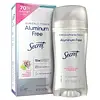What's inside
What's inside
 Key Ingredients
Key Ingredients

No key ingredients
 Benefits
Benefits

 Concerns
Concerns

 Ingredients Side-by-side
Ingredients Side-by-side

Water
Skin ConditioningCyclopentasiloxane
EmollientCI 77891
Cosmetic ColorantTrimethylsiloxysilicate
EmollientPropanediol
SolventCI 77492
Cosmetic ColorantIsododecane
EmollientDiphenylsiloxy Phenyl Trimethicone
Skin ConditioningMethyl Trimethicone
Skin ConditioningNiacinamide
SmoothingPEG-10 Dimethicone
Skin ConditioningDimethicone
EmollientOctyldodecanol
EmollientPolyglyceryl-3 Polydimethylsiloxyethyl Dimethicone
Skin ConditioningPEG/PPG-18/18 Dimethicone
Emulsifying1,2-Hexanediol
Skin ConditioningHaematococcus Pluvialis Oil
AntioxidantHibiscus Sabdariffa Flower Extract
Skin ConditioningRosa Rugosa Flower Extract
Skin ConditioningPancratium Maritimum Extract
BleachingNymphaea Alba Flower Extract
Skin ConditioningPropolis Extract
Skin ConditioningMagnesium Sulfate
Disteardimonium Hectorite
StabilisingAluminum Hydroxide
EmollientStearic Acid
CleansingPolyhydroxystearic Acid
EmulsifyingTriethoxycaprylylsilane
Alumina
AbrasivePolyglyceryl-4 Isostearate
EmulsifyingIsopropyl Titanium Triisostearate
EmollientNeopentyl Glycol Diethylhexanoate
EmollientAdenosine
Skin ConditioningTrisodium Ethylenediamine Disuccinate
Polymethyl Methacrylate
Butylene Glycol
HumectantGlycerin
HumectantDipropylene Glycol
HumectantSodium Palmitoyl Proline
Skin ConditioningCetearyl Dimethicone/Vinyl Dimethicone Crosspolymer
EmollientAstaxanthin
Skin ConditioningPotassium Sorbate
PreservativeParfum
MaskingCI 77491
Cosmetic ColorantCI 77499
Cosmetic ColorantWater, Cyclopentasiloxane, CI 77891, Trimethylsiloxysilicate, Propanediol, CI 77492, Isododecane, Diphenylsiloxy Phenyl Trimethicone, Methyl Trimethicone, Niacinamide, PEG-10 Dimethicone, Dimethicone, Octyldodecanol, Polyglyceryl-3 Polydimethylsiloxyethyl Dimethicone, PEG/PPG-18/18 Dimethicone, 1,2-Hexanediol, Haematococcus Pluvialis Oil, Hibiscus Sabdariffa Flower Extract, Rosa Rugosa Flower Extract, Pancratium Maritimum Extract, Nymphaea Alba Flower Extract, Propolis Extract, Magnesium Sulfate, Disteardimonium Hectorite, Aluminum Hydroxide, Stearic Acid, Polyhydroxystearic Acid, Triethoxycaprylylsilane, Alumina, Polyglyceryl-4 Isostearate, Isopropyl Titanium Triisostearate, Neopentyl Glycol Diethylhexanoate, Adenosine, Trisodium Ethylenediamine Disuccinate, Polymethyl Methacrylate, Butylene Glycol, Glycerin, Dipropylene Glycol, Sodium Palmitoyl Proline, Cetearyl Dimethicone/Vinyl Dimethicone Crosspolymer, Astaxanthin, Potassium Sorbate, Parfum, CI 77491, CI 77499
 Reviews
Reviews

Ingredients Explained
These ingredients are found in both products.
Ingredients higher up in an ingredient list are typically present in a larger amount.
Cyclopentasiloxane, or D5, is a silicone used to improve texture of products and trap moisture.
D5 is considered lightweight and volatile. Volatile means it evaporates quickly after application. Once evaporated, D5 leaves a thin barrier that helps keep skin hydrated.
It is also an emollient. Emollients help soften the skin and prevent water loss. Silicones create a silky texture in products. D5 helps other ingredients become more spreadable.
Studies show D5 is safe to use in skincare products. We recommend speaking with a skincare professional if you have concerns.
Learn more about CyclopentasiloxaneParfum is a catch-all term for an ingredient or more that is used to give a scent to products.
Also called "fragrance", this ingredient can be a blend of hundreds of chemicals or plant oils. This means every product with "fragrance" or "parfum" in the ingredients list is a different mixture.
For instance, Habanolide is a proprietary trade name for a specific aroma chemical. When used as a fragrance ingredient in cosmetics, most aroma chemicals fall under the broad labeling category of “FRAGRANCE” or “PARFUM” according to EU and US regulations.
The term 'parfum' or 'fragrance' is not regulated in many countries. In many cases, it is up to the brand to define this term.
For instance, many brands choose to label themselves as "fragrance-free" because they are not using synthetic fragrances. However, their products may still contain ingredients such as essential oils that are considered a fragrance by INCI standards.
One example is Calendula flower extract. Calendula is an essential oil that still imparts a scent or 'fragrance'.
Depending on the blend, the ingredients in the mixture can cause allergies and sensitivities on the skin. Some ingredients that are known EU allergens include linalool and citronellol.
Parfum can also be used to mask or cover an unpleasant scent.
The bottom line is: not all fragrances/parfum/ingredients are created equally. If you are worried about fragrances, we recommend taking a closer look at an ingredient. And of course, we always recommend speaking with a professional.
Learn more about Parfum